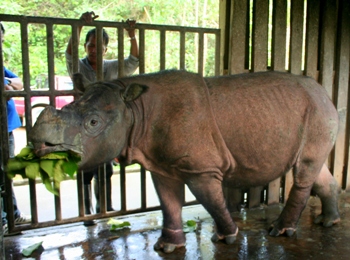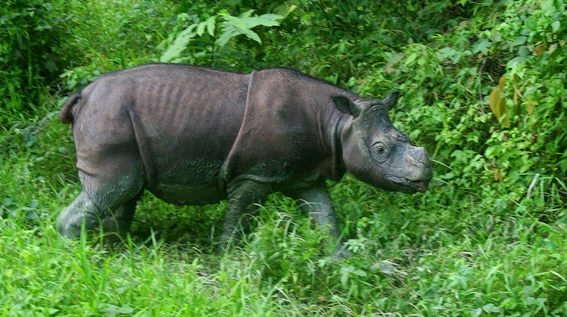Though they grew up world’s apart, Sumatran rhinos Ratu and Andalas have given conservationists new-found hope for saving the embattled species. The rhino couple is expecting, according to the Sumatran Rhino Sanctuary at Way Kambas, Indonesia. One of the world’s most endangered big mammals, Sumatran rhinos are unique due to their hairy bodies and small size (at least compared to other rhinos). The last surviving members of the genus Dicerorhinus, only 200 Sumatran rhinos are estimated to survive in the wild.
Ratu’s pregnancy holds special significance for a number of reasons. It is the first pregnancy at the Sumatran Rhino Sanctuary; it will be both Ratu’s and Andalas’ first calf; it is also the first pregnancy in captivity since Andalas’ mother Emi—the only Sumatran rhino to successfully give birth in captivity for 112 years—passed away last fall.
 This is Tam. He is a Bornean rhino–which is a subspecies of the Sumatran–that was put in captivity after he wandered onto an oil palm plantation with an injured foot. The Sumatran is the world’s smallest rhino. There are an estimated 200 Sumatran rhinos left in the world, only 40 of those are thought to be Bornean. Photo by: Jeremy Hance. |
“We have been waiting a long time to share news of a rhino pregnancy,” said Dr. Dedi Candra, the sanctuary’s animal collection coordinator. “With help from our partners, we have worked tirelessly to keep these animals healthy and breeding. Our dedicated keepers deserve a great deal of the credit.”
The expectant father, Andalas, was born across the world from Indonesia at the Cincinnati Zoo in 2001. In 2007 he was transferred to Indonesia with hopes that as a young male he would be able to successfully breed with the females at his new home. On the other hand, Ratu was born in the wild, but wandered into a village just outside Sumatra’s Way Kambas National Park in 2006.
The pair were brought together slowly. Over months they were introduced by scent, sound, sight, and finally brought together to mate.
“Sumatran rhinos are very solitary by nature and very aggressive towards one another except when a female is in estrus,” explains Dr. Terri Roth, director of Cincinnati Zoo’s Center for Conservation and Research of Endangered Wildlife (CREW) and vice president for International Rhino Foundation’s (IRF) Asia programs. “Through science we can determine when the female is ready to ovulate so that she is paired with a male at the right time and fighting is minimized while the likelihood of conception is optimized.”
Sumatran rhinos have been decimated by the trade in rhino horns for traditional Asian medicines and by large-scale deforestation for logging and oil palm plantations. The largest number of Sumatran rhinos survive in western Sumatra, but another population—and a different subspecies—survives in Borneo. Currently, plans are being developed for a similar rhino preserve in Borneo.
The Sumatran Rhino Sanctuary in Indonesia is a 250-acre complex and currently home to five of the Critically Endangered rhinos. The sanctuary is meant to provide the rhinos with a sense of their rainforest home while allowing veterinarians easy and frequent access. The sanctuary was built and funded by IRF.
“Sumatran rhino numbers have decreased by more than 50 percent over the last 15 years in the wild. Every individual counts, and the captive population represents not only an ‘insurance policy’ for the wild population, but also a means to study the basic biology of the species, which we must understand in order to save them,” said Dr. Susie Ellis, executive director of the International Rhino Foundation.
The baby rhino is expected in May 2011.

Tam in his 2.5 hectare enclosure. Photo by: Jeremy Hance
Related articles
Face-to-face with what may be the last of the world’s smallest rhino, the Bornean rhinoceros

(12/01/2009) Nothing can really prepare a person for coming face-to-face with what may be the last of a species. I had known for a week that I would be fortunate enough to meet Tam. I’d heard stories of his gentle demeanor, discussed his current situation with experts, and read everything I could find about this surprising individual. But still, walking up to the pen where Tam stood contentedly pulling leaves from the hands of a local ranger, hearing him snort and whistle, watching as he rattled the bars with his blunted horn, I felt like I was walking into a place I wasn’t meant to be. As though I was treading on his, Tam’s space: entering into a cool deep forest where mud wallows and shadows still linger. This was Tam’s world; or at least it should be.
In midst of poaching crisis, illegal rhino horn tops gold
(11/25/2009) Rhino poaching has hit a fifteen-year high, and the rising price for black-market rhino horn is likely the reason why. For the first time in a decade rhino horn is worth more than gold: a kilo of rhino horn is worth approximately 60,000 US dollars while gold is a little over 40,600 US dollars.
World’s only Sumatran rhino to give birth in captivity dies at Cincinnati Zoo
(09/10/2009) Emi, the world’s only Sumatran rhino to give birth in captivity, died on Saturday at the Cincinnati zoo. She successfully gave birth to three offspring, one of which has been released back into the wild in Indonesia.
Rhino poaching rises sharply due to Asian demand for horns
(07/09/2009) Rhino poaching rates have hit a 15-year-high as a consequence of demand for horns for use in traditional medicine, according to new report published by the wildlife trade monitoring network TRAFFIC. Asia-based criminal gangs run the illegal trade.
Scientists capture video of rare Borneo rhino

(04/24/2007) WWF has captured video footage of the rare Borneo rhino. There are only 25-50 of the rhino left in the wild on the island. Video from a camera trap shows the animal eating, walking to the camera and sniffing the equipment. It is first time the beast’s behvaior in the wild has been captured on film.
13 rare rhinos found in Borneo survey by WWF
(03/17/2006) World Wildlife Fund today released the results of a field survey from the island of Borneo which found that poaching has significantly reduced Borneo’s population of Sumatran rhinos, but a small group continues to survive in the “Heart of Borneo,” a region covered with vast tracts of rain forest.